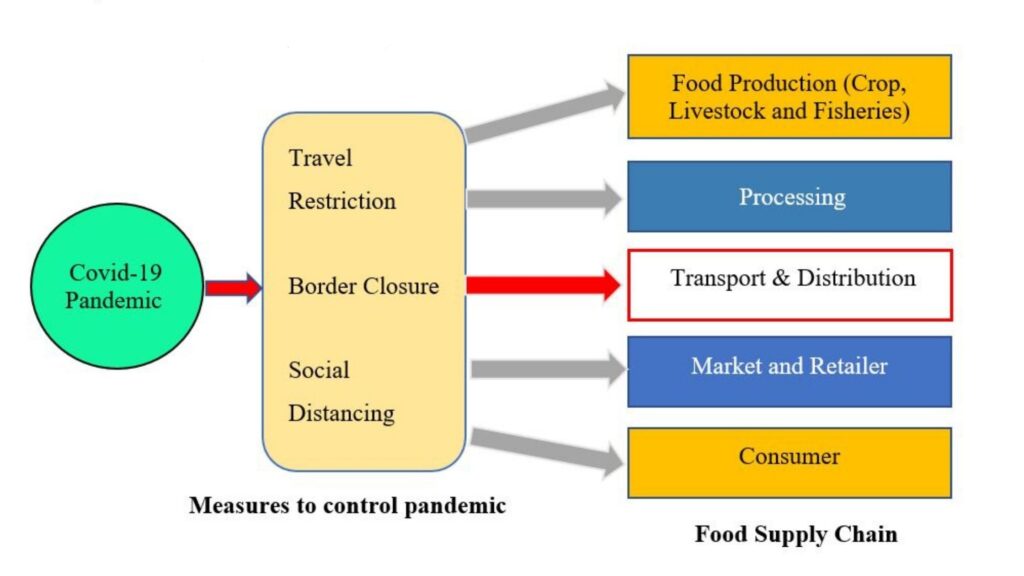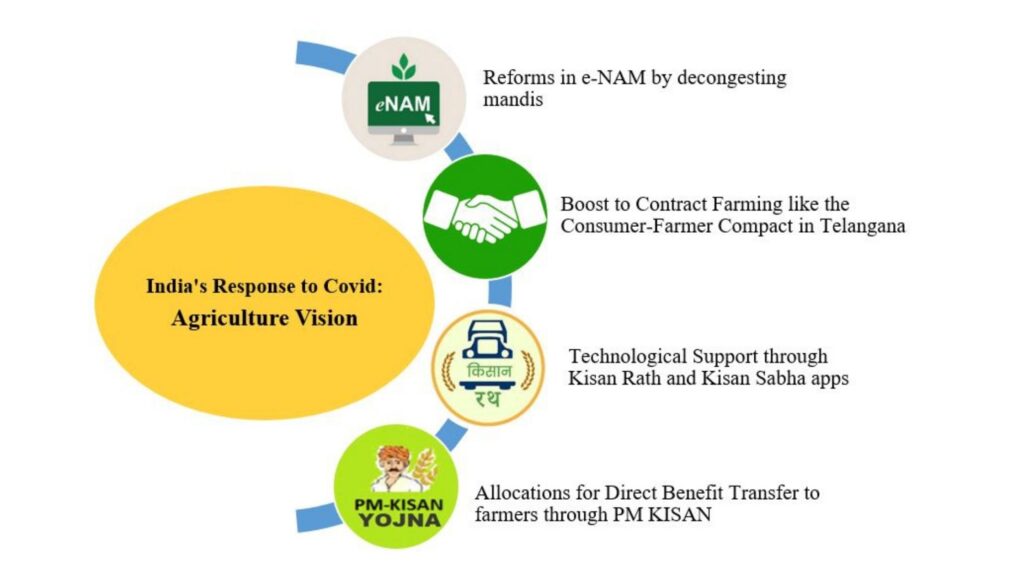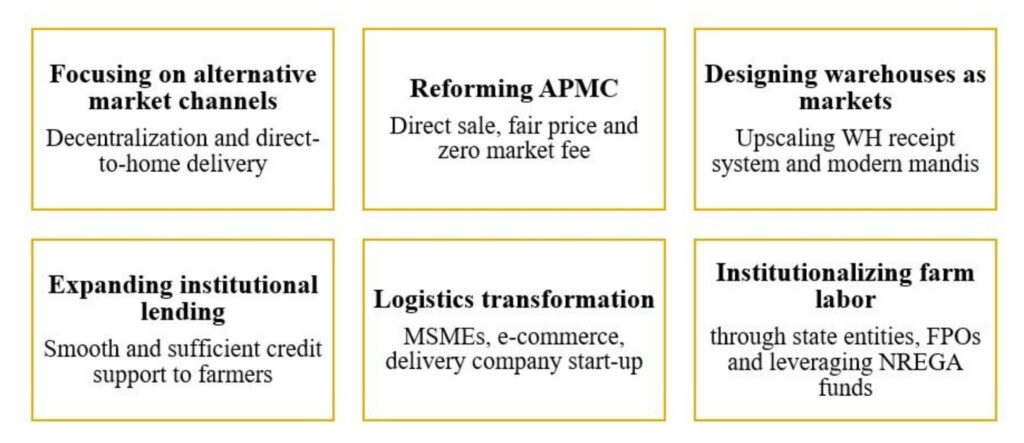The emergence of the Covid-19 pandemic pushed the whole world into a standstill situation and the lockdown period has coincided with peak harvesting season, imposing a threat to over 1 crore hectare land in India. India is the largest producer of pulses, spices, jute, milk, and tea and 2nd largest producer of rice and wheat, fruits and vegetables, cotton, poultry, and fish all over the world. Hence, the agriculture dividend shows a dependence of 58% Indians as a source of livelihood and 44% as workforce employed in the agriculture sector. This coronavirus has jammed the country’s agriculture and food security systems with varied intensity across diverse regions and stakeholders like agricultural wage laborers and producers. This severe impact will echo athwart the larger economy including other dependent sectors as well and will linger longer than a year.
Also read: How Covid-19 Changed Our World
Issues surfaced aftermath Covid crisis

Despite strict regulations, govt guidelines and continuous imposition of restrictions over vehicular traffic and individual flow of movement, concerns regarding harsh implications of the plethoric pandemic on the farm economy are always at a new high. The instantaneous collapses in agriculture in discusses under two broad heads:
- Impact on the global farm sector
- Impact on India
Impact on Global Farming Sector
1. Crop production and seed availability
The Covid pandemic depressed demand and disrupted the supply chain of food crops, fruits, and vegetables, dairy, poultry, etc. Discussing the crop production scenario, the largest duration between summer and winter of the seeding process is somehow unaffected or less affected due to selective containment zone-based lockdown impositions. So, till now, there is no such severe impact on seed availability but the major concern is what will happen next if the situation does not improve and the similar scenario continues till the year-end.
2. Undersupply of Fertilizers
Due to restrictions in intra-state movement and global trade, farmers are facing a paucity of agriculture input supplies including fertilizers, herbicides, weedicides, and pesticides. Eventually, a slight shortage has been created within a short span of lockdown months which can be a potentially higher issue of concern in the long-term since some of the fertilizer production plants have been closed down in the United States and China.
3. Food demand & food security
Amidst the worldwide lockdown, the global economy has fallen off and millions have lost their livelihoods. Due to this reduced income and purchasing power parity, the demand for food has sternly condensed. In contrast, the panicked consumers from the higher-income groups have had been stockpiling foods which in exchange affecting the market price fluctuation and food availability. Overall, international travel and trade ban may cause growing concern over disturbances in the food production process, food insecurity, and the whole supply chain.
4. Food production & distribution
To control the contagious rate of coronavirus infection, major countries have taken certain strict measures like commercial closures, travel embargos, and home confinement. As we all know, how agricultural produce is perishable in nature so the farmers become bound to hold their excess unsold produce for a longer period of time, resulting in a drop in food quality and snowballing cost of production as well.
5. Livestock
Alongside agriculture, different allied farming sectors like livestock and pisciculture have been severely hit by the uncertain pandemic crisis. In India, Covid caused a hard impact on livestock farming especially the backward linkage. For example, since the commercial standstill and travel embargos have affected, while cattle farmers are facing limited access to animal feed and labor shortage there the poultry farmers are suffering from deficient delivery of breeding stocks.
6. Workers
In most of the lower and middle-income countries, agricultural workers face a paucity of proper social protection and quality health services due to lower-income resulting in little or no savings. Notwithstanding the self-isolation protocols amid novel coronavirus contagion, the informal segment workers in agriculture are enforced to work or cultivate for their self-sustenance.
Impact on Indian Farming Sector
1. Peak harvest with zero procurement
Now, we are moving towards the peak of Rabi harvest in India with crops like wheat, paddy, mustard, lentil, gram, etc. are at a mature or harvest stage and the farmers should reach the mandis for secure procurement maneuver which system is falling down now.
2. Labor unavailability due to reverse migration
The majority of manual labor depended farm belts are suffering from a shortage of laborers due to reverse migration resulting in a higher wage rates for harvesting crops.
3. Fall in prices
The rise in labor wage costs and restricted access enforced farmers towards incurring a huge loss thus allowing crops to rot in the field as a better ‘stop-loss’ mechanism against collapsed agricultural prices due to stoppage in market access.
4. Scarcity of public goods
Where transporting PDS items to the last-mile delivery agents by road or rail was harshly impacted initially, their availing food grains, vegetables, fruits and other essential food commodities to both rural and urban consumers have become a massive challenge.
5. Restrictions on sale
According to the lockdown protocols, strict restrictions on intra and inter-state movements are there regarding farmers, farm laborers, harvested produces, and necessary farm machinery.
6. Disruptions in supply-chain
Vigilant roadblocks clubbed with defaulter transport facilities posed a delimiting effect over the movement of migratory labor, harvest, and farm machinery.
7. Debt and cash-flow constraints
April and May profoundly being the seasons of repaying crop loans and granting new loans for new season, hence if any failure to do so will lead to borrowing money from informal lenders with sky-high interest rates.
8. Hampered floriculture and fisheries
As the weddings are postponed and religious ceremonies are also halted since march in India, the flower market has come to a standstill situation. Similarly, due to transport restrictions fishing is in troubled waters now.
India’s Response to Covid-19: Agriculture Vision

Future Scope of Reforms

Future of Agriculture and Way Forward in India

Conclusion
Though India has emerged as a global food giant for decades, the Covid-19 disrupted the domestic agricultural system on three major points: production, marketing, and consumption, which led to inflation of essential commodities. Furthermore, misinformation regarding Covid contagiousness caused a steep reduction in consumption of poultry meat and fish. As the pandemic continues to threaten the global food system, the state should focus on the following points such as Social Safety Net, family farming, collective farming, staggered procurement and pricing, buffer stock and risk management, reforms in Ag. finance and investment in Ag research & development in order to safeguard a billion livelihoods associated with farming system as post-pandemic economy restoration.
Also read:



Prasun, I must say this article is a well thought and well articulated creation of yours. Searching in deep and documenting well is your greatest quality. This article will help many students and people directly and indirectly working on the issue. I congratulate you for this.
Thank you so much Pooja!